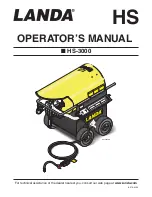
Page 10 — English
OPERATION
ADDING/CHECKING ENGINE LUBRICANT
See Figure 10.
NOTE: This machine has been shipped with approximately
2 oz. of lubricant in the engine from testing.
You must add
lubricant to the engine before starting it the first time.
CAUTION:
Any attempt to start the engine without adding lubricant
will result in engine failure.
To add engine lubricant:
Place pressure washer on a flat, level surface.
Unscrew the oil cap / dipstick by turning counter-
clockwise.
Using 4-stroke engine lubricant (SAE 30 or SAE 10W30),
add engine lubricant until the fluid level rises to the
hatched area on the dipstick (18 oz., 4-cycle engine
lubricant provided).
Do not overfill.).
Replace the oil cap / dipstick and securely tighten.
NOTE: This engine has a total lubricant capacity of
20.3 oz. (0.6 liters).
To check engine lubricant level:
Set pressure washer on a flat surface.
Wipe dipstick clean and re-seat in hole; do not
rethread.
Remove dipstick again and check lubricant level. Lubricant
level should fall within the hatched area on the dipstick.
If level is low, add engine lubricant until the fluid level
rises to the upper portion of the hatched area on the
dipstick.
Replace and secure the oil cap/dipstick.
CAUTION:
Do not overfill. Overfilling the crankcase may cause ex-
cessive smoke and engine damage.
OXYGENATED FUELS
DO NOT USE E85 FUEL. IT WILL VOID YOUR WAR-
RANTY.
NOTE: Fuel system damage or performance problems re-
sulting from the use of an oxygenated fuel containing more
than the percentages of oxygenates stated below
are not
covered under warranty.
Ethanol. Gasoline containing up to 10% ethanol by volume
(commonly referred to as E10) is acceptable. E85 is not.
ADDING GASOLINE TO THE FUEL TANK
See Figure 11.
WARNING:
Gasoline and its vapors are highly flammable and
explosive. To prevent serious personal injury and prop-
erty damage, handle gasoline with care. Keep away from
ignition sources, handle outdoors only, do not smoke
while adding fuel, and wipe up spills immediately.
When adding gas to the pressure washer, make sure the unit
is sitting on a flat, level surface. If the engine is hot, let the
pressure washer cool before adding gas. ALWAYS fill the
fuel tank outdoors with the machine turned off.
NOTE: Use unleaded gas only. DO NOT mix lubricant with
gas.
Before removing the fuel cap, clean the area around it.
Remove the fuel cap.
Insert a clean funnel into the fuel tank then slowly
pour gasoline into the tank. Fill tank to approximately
1-1/2 in. below the top of the tank neck (this allows for
fuel expansion).
Replace fuel cap and tighten until the cap “clicks”.
Clean up any spills before starting the engine.
PUMP LUBRICANT
The pressure washer pump has been filled with sufficient
lubricant at the factory. You do not need to check or add
lubricant to the pump.
STARTING AND STOPPING THE PRESSURE
WASHER
See Figures 12 - 14.
CAUTION:
Do not run the pressure washer pump without water sup-
ply connected and turned on, as this may damage the
high pressure seals and decrease pump life. Completely
unwind the hose from its reel or coil and make sure the
hose is not being restricted by tires, rocks, or any other
objects that may lessen or prevent water flow to the
pressure washer.
Before starting the engine:
Connect all hoses.
Check all fluids (lubricant and gas).
Turn on the garden hose then pull the trigger to
relieve air pressure; hold the trigger until a steady stream
of water appears.
To start the engine:
Turn the fuel valve to the ON position.
Move the choke lever to the ON (COLD START) position.















































